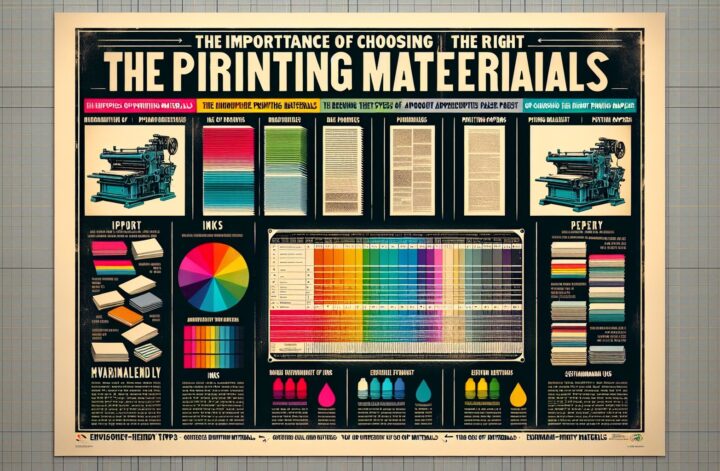Printing materials play a crucial role in the world of printing. From brochures to posters, business cards to banners, the choice of printing material can greatly impact the final result. With numerous options available in today’s market, it can be overwhelming to select the right material for your printing needs. In this comprehensive guide, we will explore a variety of printing materials, their characteristics, and their best applications.
Introduction
Printing materials encompass a wide range of options, each with its unique qualities, advantages, and disadvantages. The type of material you choose for your printing project can significantly influence its visual appeal, durability, and cost-effectiveness. By understanding the characteristics of different printing materials, you can make an informed decision and achieve the desired outcome for your printing projects.
Understanding Printing Materials
Paper
Paper is the most commonly used printing material due to its versatility and affordability. It comes in various weights and finishes, offering a wide range of options for different printing needs. Here are some popular types of paper used in printing:
-
Bond Paper: Also known as writing paper, bond paper is lightweight and often used for everyday printing purposes such as letters and documents. It is available in different weights ranging from 16lb to 28lb.
-
Coated Paper: Coated paper has a smooth and glossy finish that enhances the vibrancy and sharpness of printed images. It is often used for high-quality brochures, flyers, and promotional materials.
-
Recycled Paper: As eco-consciousness grows, the demand for recycled paper has also increased. Recycled paper is made from post-consumer waste and is available in various options, including uncoated and textured varieties.
Cardstock
Cardstock, also known as cover stock or pasteboard, is a thicker and more durable paper variety. It is widely used for projects that require sturdy materials, such as business cards, postcards, invitations, and packaging. Cardstock is available in various weights, typically measured in points, with heavier weights offering increased durability.
Vinyl
Vinyl printing materials are known for their weather-resistant properties, making them ideal for both indoor and outdoor applications. Vinyl can be printed on using various techniques, including screen printing and digital printing. It is commonly used for banners, signage, vehicle graphics, and wall murals.
Fabric
Fabric printing has gained popularity in recent years due to the rise of customizable textiles. Different types of fabric, including cotton, polyester, and nylon, can be digitally printed to create custom clothing, flags, banners, and backdrops. Fabric printing offers vibrant colors and a soft, luxurious feel.
Plastic
Plastic materials are often used for specialized printing applications requiring durability and water resistance. Common plastic printing materials include PVC, polycarbonate, and acrylic. These materials are used for items such as ID cards, name tags, product labels, and packaging.
Metal
Metal materials, such as aluminum, brass, and stainless steel, are commonly used for industrial and commercial printing purposes. Metal printing is often achieved through specialized techniques like etching, engraving, or screen printing. Metal prints are known for their durability and high-end appearance and are used for signage, nameplates, and displays.
Choosing the Right Printing Material
When selecting a printing material, several factors need to be considered:
-
Project Purpose: Determine the purpose of your project. Is it for marketing, promotion, or personal use? The purpose will help you prioritize the qualities you need in a printing material.
-
Durability: Consider the lifespan required for your project. If it needs to withstand frequent handling, outdoor exposure, or moisture, opt for a more durable material such as vinyl, plastic, or metal.
-
Printing Technique: Different materials are compatible with different printing techniques. Consult with your printer to ensure the material you choose works well with the desired printing method, whether it’s digital, offset, or screen printing.
-
Budget: Printing costs can vary depending on the material chosen. Consider your budget when selecting a material, as some options may be more costly than others.
-
Aesthetics: Determine the visual impact you want to achieve. Consider factors like texture, finish, and color reproduction to select the material that aligns with your aesthetic goals.
-
Eco-friendliness: If sustainability is a concern, explore recycled paper options or environmentally friendly alternatives like bamboo or hemp-based materials.
Conclusion
Selecting the right printing material is essential to produce high-quality, visually appealing, and durable prints. Whether you require paper for everyday printing needs, cardstock for special projects, vinyl for outdoor signage, or fabric for custom textiles, understanding the characteristics of different materials will help you make an informed decision. Consider your project’s purpose, durability, printing technique, budget, aesthetics, and eco-friendliness to find the perfect printing material for your needs. By choosing wisely, you can ensure that your printed creations leave a lasting impression.
With a vast array of printing materials available today, the possibilities for creativity and innovation are endless. So, go ahead and explore the exciting world of printing materials to bring your visions to life!

